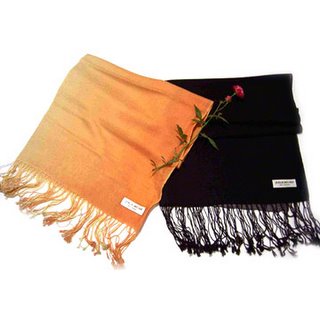
Pashmina Story
Made from the fur of pashmina, a mountain goat that scales the snow-capped mountains of Nepal, India and Tibet, these shawls for centuries have been cherished as an investment, tradition, and even art form in South Asia.
The true pashmina is made of wool from the neck and underbelly of the capra hircus, a goat that thrives only in arid Himalayan plateaus at 12,000 to 14,000 feet. The high altitude, combined with the goat's Spartan diet and special genetic makeup, enable it to grow a coat of wool among the finest and warmest on earth.
Americans are only just starting to get hooked - but they're catching the craze fast. In December, Vogue magazine deemed the pashmina shawl "fashion's cult accessory of the moment."
For centuries, silk has often been woven with pashmina to give shawls a harder finish, strength and greater body. With the advent of the 1990s silk/pashmina shawl, however, new treatment processes have been added to obtain the objectives of extraordinary softness and fluffiness. These are achieved largely by brushing the freshly loomed shawls both before and after dyeing. The result is a luxurious and light feeling fabric, which still manages to achieve the ancient pashmina standard of providing amazing warmth to its wearer.
Pashmina and Silk/Pashmina shawls are hand woven by men as only they have the strength to throw the shuttle back and forth continuously. Prior to weaving, the pashmina wool is carded and spun by women. As the entire process is almost entirely done by hand, there are small flaws and slubs that make their way into virtually every shawl. This is normal and should be seen as a sign that the fabric has been hand loomed. Dyeing is also done by hand. The undyed shawls are stirred, again by men, into large pots of simmering dye liquid. Periodically they are lifted out to be inspected. When the desired color is achieved, the shawls are rinsed, dried and treated. Because the entire dyeing process is, again, done by hand, some slight striations can be expected. Finishes can also differ because dyes have different effects on the /Silk/Pashmina fabric. This explains why some light colored shawls feel softer than other dark colored ones. If they are from the same weaver, the only difference is from the effects of the dye.
Pashmina shawls can be delicately hand-washed in cold water with a light detergent such as Woolite. They should be rolled in towels to remove excess water and laid to dry. To remove wrinkles, pashmina shawls should be either steam pressed or lightly ironed under a pressing cloth. Silk/Pashmina shawls should be dry-cleaned. Although the contents are natural products, the silk and raised pap of the fabric cause Silk/Pashmina shawls to wrinkle more easily. Because home pressing can flatten the nap, it is best to have Silk/Pashmina professionally dry cleaned.













